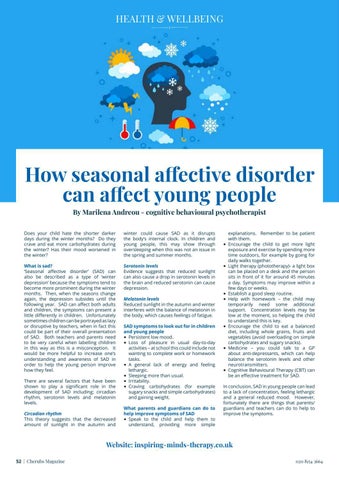HEALTH & WELLBEING
How seasonal affective disorder can affect young people By Marilena Andreou - cognitive behavioural psychotherapist Does your child hate the shorter darker days during the winter months? Do they crave and eat more carbohydrates during the winter? Has their mood worsened in the winter?
winter could cause SAD as it disrupts the body’s internal clock. In children and young people, this may show through oversleeping when this was not an issue in the spring and summer months.
What is sad? ‘Seasonal affective disorder’ (SAD) can also be described as a type of ‘winter depression’ because the symptoms tend to become more prominent during the winter months. Then, when the seasons change again, the depression subsides until the following year. SAD can affect both adults and children, the symptoms can present a little differently in children. Unfortunately sometimes children can be portrayed as lazy or disruptive by teachers, when in fact this could be part of their overall presentation of SAD. Both teachers and parents need to be very careful when labelling children in this way as this is a misconception. It would be more helpful to increase one’s understanding and awareness of SAD in order to help the young person improve how they feel.
Serotonin levels Evidence suggests that reduced sunlight can also cause a drop in serotonin levels in the brain and reduced serotonin can cause depression.
There are several factors that have been shown to play a significant role in the development of SAD including; circadian rhythm, serotonin levels and melatonin levels. Circadian rhythm This theory suggests that the decreased amount of sunlight in the autumn and
Melatonin levels Reduced sunlight in the autumn and winter interferes with the balance of melatonin in the body, which causes feelings of fatigue. SAD symptoms to look out for in children and young people • Persistent low mood. • Loss of pleasure in usual day-to-day activities – at school this could include not wanting to complete work or homework tasks. • A general lack of energy and feeling lethargic. • Sleeping more than usual. • Irritability. • Craving carbohydrates (for example sugary snacks and simple carbohydrates) and gaining weight. What parents and guardians can do to help improve symptoms of SAD • Speak to the child and help them to understand, providing more simple
explanations. Remember to be patient with them. • Encourage the child to get more light exposure and exercise by spending more time outdoors, for example by going for daily walks together. • Light therapy (phototherapy)- a light box can be placed on a desk and the person sits in front of it for around 45 minutes a day. Symptoms may improve within a few days or weeks. • Establish a good sleep routine. • Help with homework – the child may temporarily need some additional support. Concentration levels may be low at the moment, so helping the child to understand this is key. • Encourage the child to eat a balanced diet, including whole grains, fruits and vegetables (avoid overloading on simple carbohydrates and sugary snacks). • Medicine – you could talk to a GP about anti-depressants, which can help balance the serotonin levels and other neurotransmitters. • Cognitive Behavioural Therapy (CBT) can be an effective treatment for SAD. In conclusion, SAD in young people can lead to a lack of concentration, feeling lethargic and a general reduced mood. However, fortunately there are things that parents/ guardians and teachers can do to help to improve the symptoms.
Website: inspiring-minds-therapy.co.uk 52 | Cherubs Magazine
020 8154 3664






